 Together, we are the new green.
Together, we are the new green.
 And plus
And plus
Choosing &+™ is a statement of intent
A way of being true to yourself
True to your values
And true to the planet
 &+™ Brand Statement
&+™ Brand Statement
This planet is the only one we have
We’d better look after it
We’re conscious of the footprints we leave
And we take care to tread lightly
Every product we buy, we carry with us
Making our footsteps that bit heavier
Let’s lighten the load
Create new use and new value
Reduce our impact
Close the loop
Upcycled fiber from used plastic bottles
Fully traceable, fully transparent
The cycle from use to re-use
Tracked and verifiable
The clothes we wear tell a story
About who we are and what we stand for
Choosing &+™ is a statement of intent
A way of being true to yourself
True to your values
And true to the planet
Sustainability without compromise
For clothing without compromise
Together, we are the new green
 &+™ Advantages
&+™ Advantages
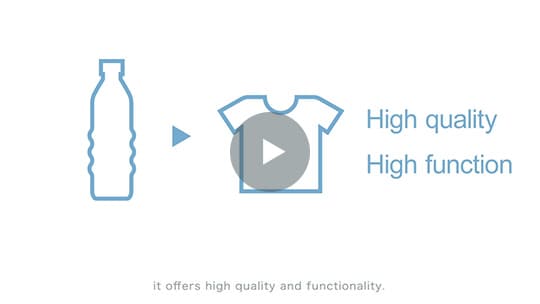
&+™ is a new fiber made from recycled PET bottles. Friendly to the environment, it offers high quality and functionality.
From recycling, to upcycling, &+™ embodies a new way of thinking designed to expand recycled fiber use, and realize a sustainable society.
CLEAN RECYCLING
In Japan, the recycling rate of PET bottles is higher than in other countries. This makes it easier to obtain high-quality used PET bottles. In addition, Toray has worked closely with Kyoei Sangyo Co., Ltd. to develop advanced technologies for sorting, cleaning, and filtering. This further reduces impurities and discoloration of recycled fibers. The result is quality, whiteness, and viscosity equivalent to fibers made from virgin petroleum-based materials.
TRACEABILITY
&+™ fibers use a proprietary Toray Recycling Identification System to ensure end-to-end traceability of recycled material content. The system complies with the international Global Recycled Standard for recycled material verification, and allows finished textile products to display exclusive Toray &+™ recycling certification labels.
AUTHENTICITY
High-quality recycled materials and proprietary manufacturing technologies enable us to create authentic &+™ fibers with a variety of cross-section profiles to suit a wide range of textile performance and functionality requirements.
 &+™ Manufacturing Process
&+™ Manufacturing Process
&+™ fibers are made from used PET bottles that are collected by local governments and shops throughout Japan. The bottles are then carefully sorted and shredded, and cleaned in an alkaline solution. The resulting material is then filtered using proprietary technology jointly developed by Toray and one of its business partners, and processed into high-purity pellets with the same whiteness and viscosity as petroleum-derived virgin material. Finally, after undergoing rigorous quality control inspections, exclusive Toray fiber manufacturing technology is used to transform the pelletized raw material into sustainable, high-quality polyester fibers.
01Collection
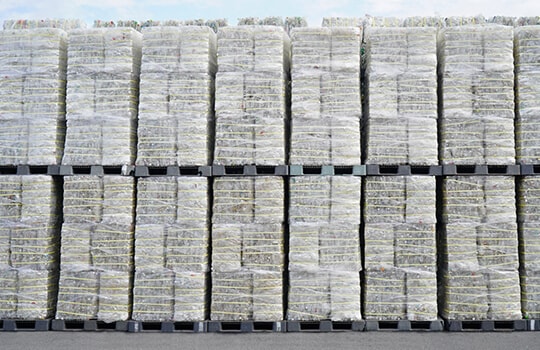
PET bottles collected by shops and local governments in accordance with Japan’s Containers and Packaging Recycling Act are compressed and packaged into bales before being sent on for processing. The bales are graded A through D according to the amount of bottle caps, labels, and other impurities they contain. Only high-quality bales are considered acceptable for the production of &+™ material.
02Sorting
Collected bottles are carefully sorted to ensure that no polyvinyl chloride bottles or colored PET bottles are included in the mix. This is done using infrared sensors and CCD cameras to identify the undesirable material so it can be removed manually. Double- and triple-checking by both machines and humans ensures that only clear and colorless PET bottles are passed on for further processing.
03Shredding
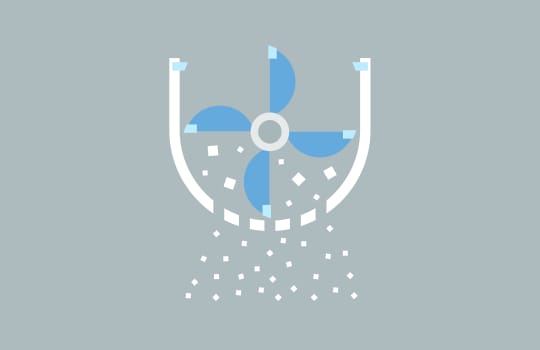
Sorted transparent PET bottles are then shredded into 8mm flakes, and non-ferrous metal separators, label separators, and blowers are used to remove any minute pieces of label material or metal fragments that may remain. (Non-PET materials removed during the shredding process are recycled as appropriate.)
04Cleaning
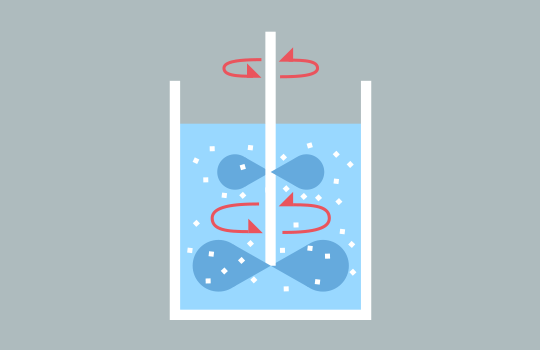
PP and PE resin cap and cap ring material that still remains in the shredded PET flakes is removed using a water-filled specific gravity separator tank. At the same time, a special alkaline solution is used to thoroughly remove other remaining impurities, surface residue, and pigmented resins. After rinsing, moisture extraction, and drying with hot air, the resulting PET flakes are exceptionally clear and transparent.
05Flakes
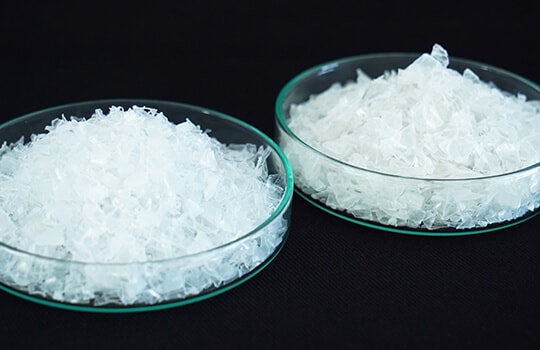
Recycled PET flakes that have undergone alkaline cleaning (left) are whiter than recycled PET flakes that are cleaned using conventional methods (right).
06Melting and extrusion
The clean, high-quality recycled PET flakes are then melted at 300°C and mixed with a special additive that has a unique chemical signature. It is this chemical signature that provides end-to-end traceability and allows finished products to be certified as containing Toray &+™ recycled PET fibers. The melted material is then extruded into strings, solidified in a cold-water bath, and cut into pellets.
07Pellets
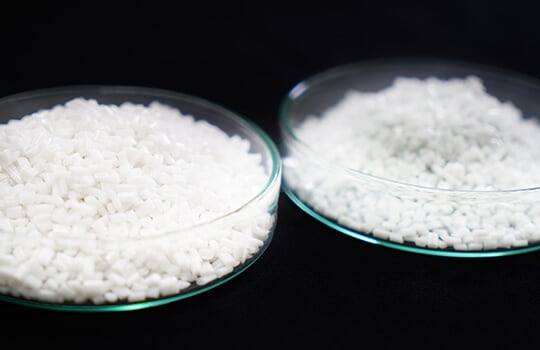
&+™ pellets made from impurity-free resin (left) are much whiter than conventional recycled pellets (right).
08Inspection
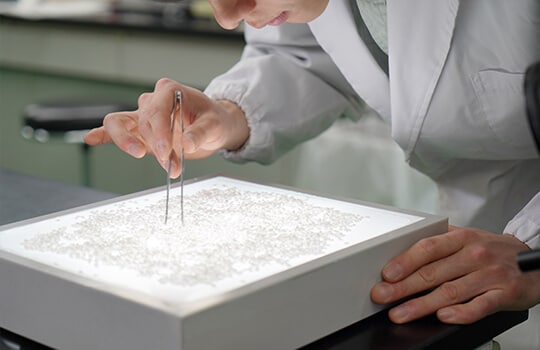
Research and inspection department personnel rigorously inspect flake and pellet materials for purity. Pellets for &+™ products are subject to particularly strict quality control standards, with pellets randomly selected from the production line for close visual inspection.
09Spinning
&+™ pellets with the same whiteness and viscosity as virgin raw materials are transformed into fibers in the spinning process. After being melted at 300°C, the liquified pellets are then extruded through nozzles and spun into fibers. By varying the shape and size of the nozzles and utilizing various processing techniques, it is possible to create fibers with functional characteristics suited to the intended application or end product.
10Apparel
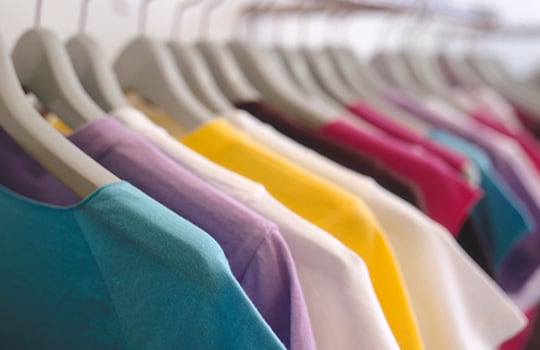
Finished &+™ fibers are shipped to textile manufacturers around the world, where they are transformed into functionally diverse fabrics for fashion apparel and sportswear in a wide range of textures and colors.

